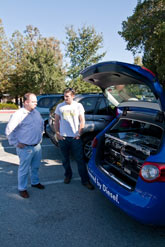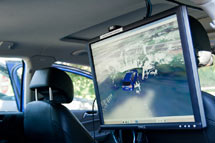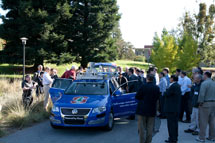
Handy Links
SLAC News Center
SLAC Today
- Subscribe
- Archives: Feb 2006-May 20, 2011
- Archives: May 23, 2011 and later
- Submit Feedback or Story Ideas
- About SLAC Today
SLAC News
Lab News
- Interactions
- Lightsources.org
- ILC NewsLine
- Int'l Science Grid This Week
- Fermilab Today
- Berkeley Lab News
- @brookhaven TODAY
- DOE Pulse
- CERN Courier
- DESY inForm
- US / LHC
SLAC Links
- Emergency
- Safety
- Policy Repository
- Site Entry Form

- Site Maps
- M & O Review
- Computing Status & Calendar
- SLAC Colloquium
- SLACspeak
- SLACspace
- SLAC Logo
- Café Menu
- Flea Market
- Web E-mail
- Marguerite Shuttle
- Discount Commuter Passes
-
Award Reporting Form
- SPIRES
- SciDoc
- Activity Groups
- Library
Stanford
Around the Bay
Autopilot Car Demo a Highlight at Navigation Symposium
|
Jan Becker (left) and Mark Baybutt (right) explain the
computer system that Junior uses to compile incoming data
and calculate the best route. (Photo by Nicholas Bock.)
Junior's laser scanner produces precise images of the
car's surroundings, which appear on this monitor in the back
seat of the car. (Photo by NIcholas Bock.)
"Junior," Stanford University's autonomous vehicle, made an appearance at SLAC yesterday. The award-winning car demonstrated its capabilities as part of a joint symposium for the Stanford Center for Position, Navigation and Time and the Center for Automotive Research at Stanford. The third annual PNT Symposium, held at Kavli auditorium October 21–22, has brought together 160 participants from 58 organizations to focus on developments in positioning, navigation and time. "This is a unique opportunity for experts from industry, academia, government and the military to network and share ideas," said meeting organizer and Executive Director of the Stanford Center for Position, Navigation and Time Tom Langenstein. The attendees heard about new U.S. plans for GPSIII as well as new navigation satellites, technology and applications, such as automated vehicle navigation. Before Junior's appearance, Jan Becker, Principle Engineer at the Bosch Research and Technology Center in Palo Alto, gave a presentation explaining autonomous vehicle technology and how it may apply to future driver assistance programs. Junior navigates the roads using six Bosch radar sensors, high precision GPS, a spinning laser scanner consisting of 64 pulsed laser beams, and a high-precision map. The radar sensors have 150–200 meters of visibility from the front and rear of the car, while the GPS device provides positioning down to one or two meters. But it is the pulsing lasers that give the car its precision. Junior's computer receives more than 1.3 million data points per second from the lasers to create a detailed map of its surroundings down to the lane markers. Attendees of the Position, Navigation and Time Symposium gather around
Junior for a question and answer session before the demonstration. (Photo by Lauren Knoche.)
"The computer gathers information from the sensors and communicates with the car," said Mike Sokolsky, Hardware Engineer from the Stanford Artificial Intelligence Lab. While Junior can drive without human guidance, Sokolsky and Stanford graduate student Mark Baybutt rode inside to monitor computer output during the demo, and were ready to take the wheel in case the car drifted from its lane. But they were not worried. "An autonomous car is very safe," Sokolsky said. "It is predictable, not irrational like human drivers, and the car knows the physics behind its driving." —Lauren Knoche |


